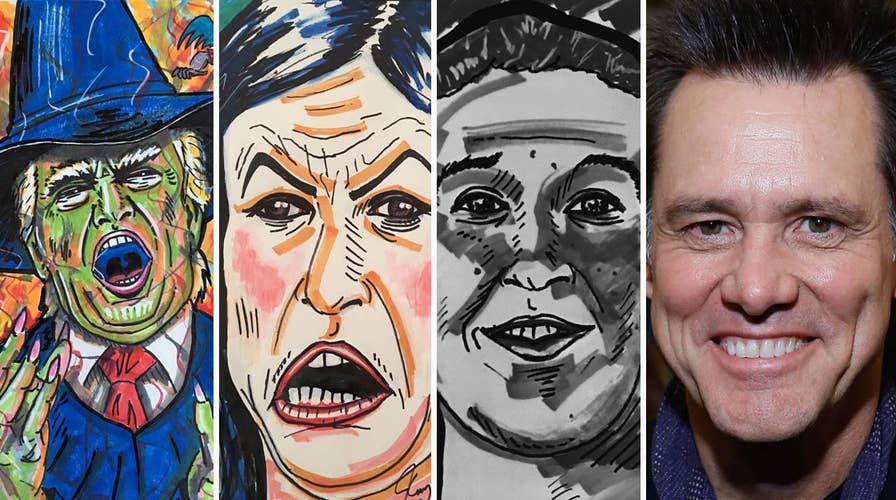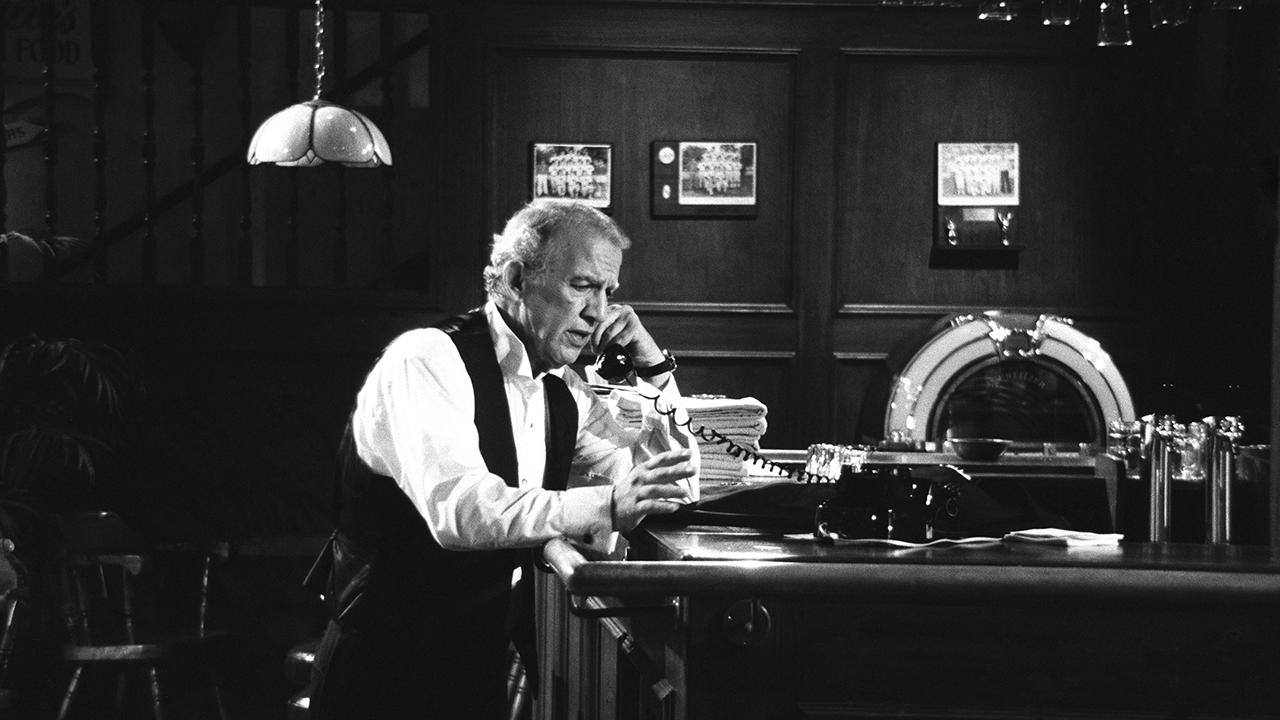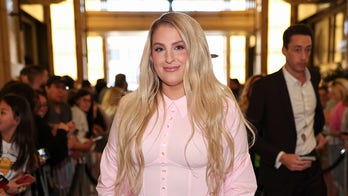Jim Carrey under fire for controversial paintings
Comedian Jim Carrey has come under fire for his recent paintings of Sarah Sanders, Facebook founder Mark Zuckerberg, and one depicting Trump as the Wicked Witch of the West.
Jim Carrey has been turning heads recently with a slew of paintings that lean on the genre of political satire. While many see the 56-year-old’s shift from comedy icon to activist painter jarring, the truth is that his life and career were built on an almost compulsive need to experiment and reinvent.
Last year, the star released a short video titled “I Needed Color,” explaining his new obsession with painting and how it’s helped him express himself and break free of depression. The film came shortly after the suicide of his ex-girlfriend Cathriona White at 28. Her family alleged in court that Carrey played a role in her decision to take her own life, but he was cleared of those charges.
"I am shocked and deeply saddened by the passing of my sweet Cathriona," Carrey said in a statement at the time of her death. "She was a truly kind and delicate Irish flower, too sensitive for this soil, to whom loving and being loved was all that sparkled. My heart goes out to her family and friends and to everyone who loved and cared about her. We have all been hit with a lightning bolt."
Since that time, the star has made headlines for portraits that bash the president and members of his administration such as Sarah Sanders, Rudy Giuliani and the first lady. He’s painted graphic portraits about school shootings as well as artwork that makes a statement on immigration. A cursory look at his Twitter will showcase a stunning number of paintings that speak to his political beliefs, a far cry from the persona that became famous as a pet detective prone to talking through his butt cheeks.
The boy wonder
The public shift to painting came soon after the controversy surrounding his ex, prompting many fans to connect the two dots and assume he was having some kind of breakdown. However, in the video he alleges that he got into painting well before that. In reality, the star’s life and meteoric rise to fame is nothing if not a portrait of a man who feels the constant need to, for better or worse, reinvent what he does.
In almost every interview about Carrey’s early life, friends and family described him as a natural cut-up, a born comedian with an innate desire to make everyone around him laugh and the physical ability to do it. However, in recent years the star has seemed less concerned with jokes and more concerned with his politically charged messages.
That happy-go-lucky kid was forced all too quickly into the real world at age 13 when his father lost his job in Canada as an accountant. The family experienced real poverty that forced him and his three siblings to make money to keep the family afloat. Things got so bad that he was forced to drop out of high school during his freshman year.
In the first big character change of his life, the kid who just wanted to make everyone laugh reportedly became noticeably less plucky as anxiety and depression began to creep into his mind. According to an “A&E Biography” done on Carrey in 1999, his father encouraged his comedic behavior even more at this time. When he was 15, his dad drove him to a comedy club called Yuk Yuk’s Stand Up in Canada, where the youngster promptly bombed on stage.
The experience stung, as it kept him from performing again for two years. However, when he gave it another shot, his impressions would take him on a rocket ride to stardom.
"People need motivation to do anything. I don't think human beings learn anything without desperation," Carrey said of his success in a 2004 interview with CBS News. "Desperation is a necessary ingredient to learning anything, or creating anything. Period. If you ain't desperate at some point, you ain't interesting."
At 17, he was taking the stage at comedy clubs and winning audiences over with his act, which was mostly impressions. People magazine labeled him one of its hottest young comics for his act, which not only showcased voice work but utilized the performer’s ability to contort his face to match the character. In addition to catching the attention of audiences in Canada, he got himself on the radar of famed comedian Rodney Dangerfield.
The comedian gave the young buck his first big break by letting him open for his Las Vegas shows. It was the first time Carrey got a sense that his passion for being silly could help pay his family’s bills. After a few forays into Los Angeles, he moved to try and make it as a comedian at 19. It didn’t take long before he was recognized and landed his first role on a sitcom in “The Duck Factory.”
But he was cast as a straightforward character, which meant his typical unhinged nature had to be put in a cage. The show was canceled after 13 weeks. From Jim’s perspective, he’d taken his shot in show business and the public had rejected him. He had no concept of the level of fame he would one day achieve. To make matters worse, his mother became ill around the same time. Once again, money became a big issue in the Carrey household.
It was time for a change.
Making a big impression
Today, Jim catches flak for abandoning his own playbook to seek fulfillment in painting. However, throwing out his own playbook is a key reason that his career didn’t get lost in the Hollywood shuffle after the cancellation of “The Duck Factory.”
After making a name for himself as the best young impressionist in the business, the star felt he had to say goodbye to the act that got him this far.
"I found myself coming up with all these ideas that didn't fit into the format of John Wayne sitting in a restaurant, or whatever. So I couldn't do them. I was an 'impressionist.' So, people wanted impressions. It's like if you go onstage and you juggle. If you juggle for five minutes at the end of your act, you're a juggler,” he told Roger Ebert in 1994.
“And so I just stopped doing impressions. I completely cut them out and [Comedy Store owner] Mitzi Shore… went nuts. 'You're the King of Impressions!' she said. I said, what's my thrill going to be? That I walk up to Clint Eastwood and do Clint Eastwood for Clint Eastwood? It's nothing to me,” he continued. “I said, 'Hey, Mitzi, they freaked out when Bob Dylan went electric. People don't like change.'”
Carrey returned to performing, this time without his 115 impressions behind him. His new style was wild and improvisational. He told Ebert that he made the choice to go up on stage every night and refuse to say the same thing twice. Some nights, Carrey’s natural talent got him through his set. However, he also said that other nights ended with him fighting off angry audience members with a bottle.
In a 2017 interview on “The Late late Show with James Corden,” Carrey recalled refusing to leave the stage for two hours one night.
“I was messed up going in,” he said “I went to the Comedy Store with the expressed idea of getting into a war with the crowd, and I did.”
His persistence paid off. Carrey soon landed a role as the only white male on Fox’s “In Living Color.” Unlike his previous sitcom, this show gave Carrey permission to be as wild and crazy as he wanted to be. Thanks to him, the show reached new levels of popularity and made Carrey a safe bet to helm his own movie.
His real big break
In 1994 he starred alongside Courteney Cox in “Ace Ventura: Pet Detective.” The film, which went on to be immensely popular and stays with fans to this day, kicked off a banner year for the guy who told jokes so that his family could stop living in a van. “Ace” would be followed by “The Mask,” which earned him his first Golden Globe nomination, as well as “Dumb and Dumber.” The following year, he played The Riddler in “Batman Forever,” followed quickly by “Ace Ventura: When Nature Calls” and “Liar Liar,” which earned him a second Golden Globe nomination
Suddenly, money wasn’t a problem. But it didn’t matter as much after his mother died in 1991. She never saw the immense fame that her son achieved the mid ‘90s. With a healthy bank account, Carrey was free to see where success and fame could take him. Despite his immense popularity, the need to experiment and reinvent himself would soon lead to another change.
The sad clown
Today, Carrey receives backlash from former fans who would prefer he stick to comedy rather than throw his hat into the political arena. However, that criticism is nothing he didn’t already hear when pivoting away from comedy to more dramatic roles.
After director Peter Weir noticed him in the poster for “Ace Ventura,” he tapped him to star in his next movie, “The Truman Show.” In 1998, after eight years of successfully making it in comedy, Carrey found himself starring in a dramatic role with almost no comedic elements.
“I ran into a lot of criticism …'Be the comedian. Like why is he trying to do that? They're all trying to do that,' kind of thing. And, I believe in that side of myself, absolutely," Carrey told CBS News. "So, I'm willing to lose everything to express that side of myself. I'm willing to give it all up."
Carrey won his first Golden Globe for that performance in 1999.
Despite getting his start as one of the most naturally talented funny men in show business, the next few years made comedies like “Me, Myself & Irene” and “How the Grinch Stole Christmas” feel more like outliers among more dramatic roles like “The Truman Show,” “Eternal Sunshine of the Spotless Mind,” “Man on the Moon,” which earned him his second Golden Globe win, and “The Majestic.”
By the mid-to-late 2000s, he seemed comfortable going back and forth between drama and comedy. He didn’t, however, see another year of successes like the unique flash in the pan that was 1994. Although he strived to reinvent himself, audiences were not seeing as much of the comedian who changed the game as they’d have liked.
The next time Carrey’s name came up in the public eye, it was his first foray into political activism.
“In all good conscience”
After acting in the action comedy “Kick-Ass 2” in 2013, the star withdrew his support for the film shortly before its release. He took to Twitter to explain that the shooting at an elementary school in Newtown, Connecticut, changed his attitude.
"I did Kickass a month b4 Sandy Hook and now in all good conscience I cannot support that level of violence," he wrote, adding: "I meant to say my apologies to others involve[d] with the film. I am not ashamed of it but recent events have caused a change in my heart."
Fans of Carrey’s and the comic book franchise on which the movie was based were quick to criticize him. However, in the context of a man who did things like drop out of high school, throw away a very successful impressionist career and switch to drama at the height of his comedic popularity, the drastic move is slightly less surprising.
Today, Carrey’s public life seems to exist solely in his art studio and on Twitter, which plays home to some of his most jarring political paintings and the scathing captions to go along with them. The responses from fans are a mix of approval from for his sharp views on the current administration as well as outrage over the graphic images and the deviation from comedy.
However, after six years of painting, it seems he’s once again looking to experiment with something new. Later this year he’ll debut his first return as a series regular in TV since his days on “In Living Color” with the Showtime series “Kidding.” He’ll work alongside director Michel Gondry, who previously collaborated with Carrey on “Eternal Sunshine of the Spotless Mind,” to play Jeff a.k.a Mr. Pickles, a children’s television icon who struggles with some dark realities.
As for whether or not the painting will stop while he tries out yet another new thing, only Carrey knows.







